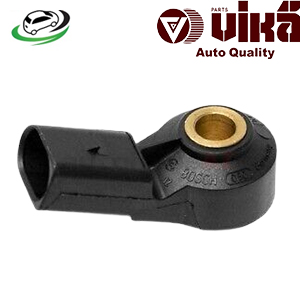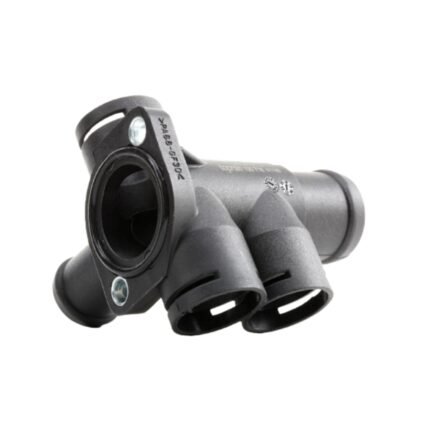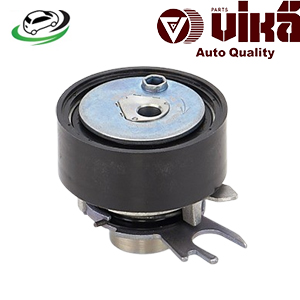Get AUDI A2 (8Z0) / VW Bora I (1J2)/ Golf IV (1J1)/ Golf V (1K1)/ Golf VI (5K1)/ Polo (6N2/ Lupo I (6X1 6E1) Cambelt tensioner 036109243AF
The cambelt tensioner works in conjunction with the timing belt, adjusting itself to maintain constant pressure on the belt. This ensures that the timing belt is neither too loose nor too tight. The tensioner can either be manually adjusted or automatically adjusted, depending on the type of tensioner installed.
Here’s a closer look at how a cambelt tensioner operates:
- Tensioner Pulley: The cambelt tensioner typically consists of a pulley that presses against the timing belt. This pulley can pivot or move to apply the correct amount of tension, compensating for belt elongation or thermal expansion.
- Spring-Loaded Mechanism (Automatic Tensioners): Many modern cambelt tensioners are equipped with a spring-loaded mechanism. This automatic tensioner applies continuous pressure on the belt, adjusting for changes in belt length caused by temperature fluctuations, wear, or slack due to engine operation.
- Manual Tensioning (Older Systems): In some older systems, the tensioner requires manual adjustment. A mechanic must manually adjust the tensioner during installation or maintenance to apply the correct tension to the belt.
The tensioner works continuously as the engine runs, keeping the timing belt tight enough to avoid slippage while allowing enough slack for smooth operation.
3. Functions of a Cambelt Tensioner
The cambelt tensioner performs several critical functions:
- Maintaining Proper Belt Tension: Its primary function is to ensure that the timing belt is always properly tensioned. This helps maintain the precise timing between the crankshaft and camshaft, which is essential for proper engine operation.
- Reducing Belt Slippage: A loose timing belt can slip off the pulleys or cause the camshaft and crankshaft to fall out of sync, leading to poor engine performance, misfires, or even serious internal damage.
- Preventing Belt Over-Tension: An overtightened belt can cause premature wear, stretching, or even breaking of the belt. The tensioner prevents this by keeping the belt at the proper tension level.
- Minimizing Noise and Vibration: The tensioner helps reduce noise and vibrations from the timing belt by ensuring a smooth operation between the crankshaft and camshaft.
4. Types of Cambelt Tensioners
There are two main types of cambelt tensioners used in vehicles:
1. Automatic Tensioners
Automatic tensioners are more common in modern vehicles. These tensioners adjust themselves automatically using a spring-loaded mechanism. As the belt stretches over time due to wear and heat, the spring inside the tensioner applies constant pressure, keeping the belt taut.
Advantages:
- Minimal Maintenance: Since they adjust automatically, there’s no need for manual intervention once installed.
- Consistent Tension: They maintain proper tension throughout the life of the belt.
Disadvantages:
- Higher Cost: Automatic tensioners are generally more expensive than manual ones.
- Potential Failure of Spring Mechanism: Over time, the internal spring could wear out, leading to loss of tension if not replaced.
2. Manual Tensioners
Manual tensioners require periodic adjustment by a mechanic. These tensioners were common in older vehicles and simpler engine designs.
Advantages:
- Lower Initial Cost: Manual tensioners are cheaper to manufacture and replace.
- Simple Mechanism: Their straightforward design makes them easy to understand and work with.
Disadvantages:
- Higher Maintenance: Manual tensioners need regular inspections and adjustments.
- Risk of Incorrect Tension: If not adjusted properly, they can lead to either a loose or overtight belt, potentially causing engine problems.
5. Benefits of a Properly Functioning Cambelt Tensioner
A functioning cambelt tensioner is essential for maintaining the overall health and performance of the engine. Its benefits include:
- Prevents Timing Issues: A well-maintained tensioner keeps the timing belt in the correct position, ensuring the engine’s valves and pistons move in sync. This prevents issues like misfires, poor engine performance, and serious damage to the internal components.
- Increases Belt Lifespan: By maintaining the proper tension, the tensioner reduces stress on the belt, prolonging its lifespan and minimizing wear.
- Improves Fuel Efficiency: A properly timed engine runs more efficiently, consuming less fuel and reducing emissions. The tensioner plays a direct role in ensuring optimal engine timing.
- Reduces the Risk of Engine Damage: If a timing belt slips or breaks due to improper tension, it can lead to severe engine damage. Valves may collide with pistons in interference engines, potentially destroying the engine. A properly functioning tensioner helps prevent such catastrophic failures.
6. Symptoms of a Failing Cambelt Tensioner
A faulty cambelt tensioner can lead to serious engine issues. Some common signs of a failing tensioner include:
- Squealing or Rattling Noise: A worn-out or loose cambelt tensioner may cause the timing belt to slip, creating a high-pitched squealing noise or a rattling sound from the engine bay.
- Engine Misfires or Rough Idling: If the timing belt slips due to improper tension, the engine may misfire or run roughly, particularly at idle.
- Illuminated Check Engine Light: The vehicle’s onboard diagnostics system may detect timing issues caused by a bad tensioner, leading to a check engine light.
- Visible Wear on the Timing Belt: If the belt shows signs of uneven wear, cracks, or fraying, the tensioner may not be maintaining proper tension, leading to accelerated belt wear.
- Loss of Power or Poor Performance: A loose or slipping belt can cause the engine to lose power or struggle to maintain consistent performance.
7. Maintenance and Replacement of Cambelt Tensioner
Proper maintenance of the cambelt tensioner is essential to avoid costly engine repairs. Below are some maintenance tips and replacement guidelines:
- Regular Inspection: Check the tensioner for any signs of wear or damage during regular maintenance intervals. Most manufacturers recommend inspecting the tensioner when replacing the timing belt.
- Timing Belt Replacement: The cambelt and tensioner are often replaced together. Timing belts typically need replacement every 60,000 to 100,000 miles, depending on the vehicle. The tensioner should be inspected and replaced as necessary during this service.
- Look for Signs of Belt Wear: During inspection, examine the timing belt for wear patterns that might indicate improper tension. If the belt is worn unevenly, it may be due to a faulty tensioner.
- Replace When Necessary: If the tensioner is making noise, showing visible wear, or not maintaining proper tension, it should be replaced. Continuing to drive with a faulty tensioner can result in severe engine damage if the timing belt slips or breaks.
8. Common Misconceptions
- Only the Timing Belt Needs Replacement: Some drivers believe that only the timing belt requires replacement during service. However, it’s recommended to replace the tensioner and other related components (like the water pump) during the timing belt replacement to ensure long-term reliability.
- Manual Tensioners Are Always Better: While manual tensioners are more affordable, they require regular adjustments, making automatic tensioners more convenient and reliable in the long run for most modern vehicles.
Conclusion
The cambelt tensioner is an essential component in maintaining engine timing and overall performance. By keeping the timing belt under proper tension, it ensures that the engine operates smoothly and efficiently. Regular inspection and timely replacement of both the tensioner and timing belt are critical to avoiding engine misfires, poor performance, and potential catastrophic engine failure.
Follow us on Facebook for more parts.




Reviews
Clear filtersThere are no reviews yet.